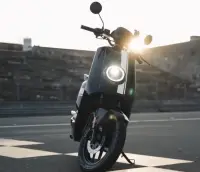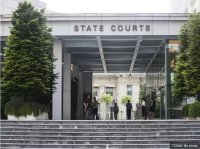.thumb.jpg.942d9c8d2090d78b3319f3cc3d3744e6.jpg)

The small-displacement inline-four sportbike we never thought we’d see.
The Kawasaki Ninja ZX-4RR hearkens back to bikes like the Kawasaki ZXR-400R, Yamaha FZR400RR SP, Honda CBR400RR, Suzuki GSX-R400, and the Honda V-4-powered VFR400R (NC30), none of which came to the US except as gray market imports.Kawasaki Ups
The only four-cylinder 400 on the market rekindles old feelings for the 400cc mini-superbikes that were popular in Japan in the 1980s and ‘90s 16,000 rpm redline, modern tech, and 15 pounds lighter than the Ninja ZX-6R It’s just begging for race trim Downs
Only costs $1,000 less than a Ninja ZX-6R Steel frame isn’t as trick as the aluminum frames that are standard on race-replica sportbikes Verdict
The 2023 Kawasaki Ninja ZX-4RR’s spec sheet demolishes that of every other small-displacement sportbike on the market. In a field of twins and singles, the ZX-4RR’s four cylinders are an ace in the hand, making it the lightweight sportbike many riders have been dreaming about since the 1980s—complete with rider aids that were barely being imagined back then. The only downside? Price of admission.
From the nose, it’s clear that the ZX-4RR is no Ninja 400—just look at that oversized ram air duct, which feeds the airbox via intake funnels in two different lengths of 40 and 60mm. The engine’s oversquare bore allows for more valve area with 22.1mm intake and 19mm exhaust valves. Available only in KRT Edition livery, the ZX-4RR looks the Kawasaki sportbike part.Kawasaki
Overview
The Kawasaki Ninja ZX-4RR is a 399cc inline-four sportbike—a mini pseudo-superbike that hearkens back to the 1980s and ‘90s when the Japanese market was flush with exotic, state-of-the-art 400cc sportbikes. The class was a hotbed of activity in Japan partly because of a licensing system that made bikes of 400cc and below much easier and less expensive to get permits for than larger-displacement machines.
So, how is a 400cc inline-four sportbike relevant to today’s US market? After 2008, manufacturers realized that the combination of high insurance premiums and empty pockets hadn’t changed riders’ taste for performance. The answer was highly capable but simplified motorcycles—many of them twins—at prices people can more easily afford and that raise fewer red flags with insurance companies.
While new-style mid-displacement twins are great, so too is the high sweet song of the inline-four, particularly in full-on sportbike trim. With the ZX-4RR, Kawasaki must be thinking: let’s spec out a bike whose displacement is too small to frighten insurers, and then let’s see how much of the traditional superbike look we can roll out at a price a lot of riders can pay.
In addition to a four-cylinder engine, the ZX-4RR uses radial-mount calipers, adjustable suspension, an assist and slipper clutch, a TFT dash, and electronic rider aids derived from Kawasaki’s top-end sportbikes. The thought of those four small 57mm pistons whirring away at 16,000 rpm is enough to excite the most jaded sportbike aficionado. This is no mere Ninja 400. However, for the sake of affordability, the ZX-4RR veers away from the Japanese-market 400s of yore by using a steel frame and swingarm instead of pricier aluminum numbers.
In certain ways, the ZX-4RR is history in reverse. Take for example the historical trajectory of the 600 supersport: for years, performance-with-economy was the philosophy behind, for instance, Honda’s CBR600F Hurricane and Kawasaki’s GPz600R, which used steel frames and budget-friendly components. In Japan, that whole concept was scrapped in the heat of the performance wars that defined the 400cc sportbike class. Eventually, America and Europe would come to demand bleeding-edge race-replica 600s. Now, it seems, economic realities, tetchy insurance agents, and emissions standards have caught up with us. Three decades later and half a world away, as the popularity of the 600 supersport class wanes, there’s finally a fully modern, albeit less exotic, 400cc four-cylinder sportbike begging to be run at redline and at the edge of its tires.
The ZX-4RR will be a great bike for occasional trackdays.Kawasaki
Updates for 2023
The Kawasaki Ninja ZX-4RR is all-new for 2023, though based on the Asian-market Ninja ZX-25R. Styling bears a strong resemblance to other motorcycles in the Ninja line, but that small-displacement four immediately marks it as something unique.
Pricing and Variants
The Ninja ZX-4RR KRT Edition is available for $9,699.
Competition
The ZX-4RR is essentially in a class of one, as Kove is the only other manufacturer adding a 399cc inline-four sportbike to its lineup. In every other way, the ZX-4RR far outpaces similarly displaced machines in terms of spec, number of cylinders, and price. While those budget-oriented machines are largely aimed at beginning riders with a focus on street riding, the 4RR is geared more toward riders who value light weight above all else, and who may wish to take their bike to the track.
Accordingly, 600cc supersports, like Kawasaki’s Ninja ZX-6R ($10,699), the Honda CBR600RR ($12,099), and Suzuki GSX-R600 ($11,699), though a step up in price, will likely make buyers think twice. But as a lightweight, high-rpm alternative, the ZX-4RR is really the only choice. Your local track will probably be full of ‘em.
Spent gases exit the engine into four header pipes that have joint pipes in between them, then into a under-engine collector with a trio of catalytic converters (expensive, and part of how the bike is able to meet current emissions requirements), and then into a long traditional-looking sportbike silencer.Kawasaki
Powertrain: Engine, Transmission, and Performance
At the heart of the ZX-4RR is a liquid-cooled DOHC 16-valve inline-four displacing 399cc. Bore and stroke measure 57.0 x 39.2mm, which is almost identical to the 1990 ZXR-400R, which measured 57.0 x 39.0mm and displaced 398cc. From there, however, this new engine is fully modern, benefiting from more than 30 years of technological advancement, including electronics that simply didn’t exist back then. Engine redline is 16,000 rpm. Although the US press kit only quotes torque figures (26.5 lb.-ft. at 11,000 rpm), UK press kits list power at 77 hp (without ram air) and 80 hp (with ram air). At least this provides a ballpark figure.
Feeding the engine are 34mm throttle bodies with Kawasaki’s latest Electronic Throttle Valves (ETV), allowing the high-spec ECU (rider aids are discussed below) to precisely control both the fuel to the injectors and the air entering the intake stream.
Ultralightweight cast-aluminum pistons have a molybdenum coating on the skirts for durability, while a reasonable 12.6:1 compression ratio ensures regular gasoline can be used (for reference, the 1990 model’s compression ratio was 12.1:1). Pistons slide in die-cast aluminum cylinders with an open deck design. The connecting rods have a carburizing treatment to help improve durability, while the crankshaft’s light flywheel mass contributes to the engine’s quick-revving nature.
Power is passed through Kawasaki’s Assist & Slipper clutch into the six-speed transmission that comes with a standard Kawasaki Quick Shifter (KQS) that allows clutchless up- and downshifts.
The ZX-4RR uses a cost-effective steel-trellis frame and a steel banana-style swingarm. The wheelbase measures 54.3 inches, identical to the Asian-market Kawasaki ZX-25R that the 4RR is largely based on.Kawasaki
Chassis/Handling
While the trick 400s of old brought stout aluminum perimeter frames to the public (they’d previously only been used in Grand Prix racing), the ZX-4RR uses a cost-effective steel-trellis frame and a steel banana-style swingarm. Claimed wet weight is 415 pounds, so expect about 391 when weight of the 4.0 gallons of fuel is subtracted. Looking at the spec chart, we see that the wheelbase measures 54.3 inches, which happens to be identical to the Asian-market Kawasaki ZX-25R, that this 4RR is largely based on. Front-end geometry has 23.5 degrees of rake and 3.8 inches of trail, which are actually a bit more aggressive than the 250′s and quite similar to the quick-steering 400s of old.
Like the ZX-25R, the ZX-4RR utilizes a 37mm inverted Showa SFF-BP (Separate Function Fork-Big Piston) fork with provision for spring preload adjustment. The advantages of this fork are that a larger-diameter damping piston is used compared to a cartridge-style fork. This reduces damping pressure which allows the stanchions to move more freely. The rear suspension features a horizontal back-link-mounted Showa BFRC (Balance Free Rear Cushion) Lite shock. The position of the shock and link is above the swingarm which also gets it out of the way of engine and exhaust heat. The shock has provisions for preload, compression, and rebound damping adjustment.
The ZX4RR has conventional (not lean-angle sensitive) ABS and uses four-piston radial-mount calipers.Kawasaki
Brakes
Braking is handled by a pair of radial-mount four-piston calipers up front. The calipers have a pair of 32mm pistons in the upper body and two 30mm pistons in the lower section. Twin 290mm semi-floating discs are used up front while a 220mm disc with a single-piston caliper is used for the rear. The latest Nissin ABS control unit is used, but there is no mention of a six-axis IMU, so that means a traditional ABS system without lean-angle-informed intervention.
Fuel Economy and Real-World MPG
Fuel numbers for the ZX-4RR are not currently available.
Ergonomics: Comfort and Utility
The ZX-4RR has slightly more relaxed ergonomics than purebred supersports like the ZX-6R and ZX-10R. Clip-ons have a slight rise for comfort on the street.
The rider interface to access settings is anchored by a 4.3-inch full-color TFT display. Multiple screen modes can be selected, including a circuit mode that prominently displays track-related information such as the lap timer, tach, and gear-position indicator. The display can also be customized with dark or light themes and the brightness level is automatically adjusted based on ambient lighting conditions. Using Rideology the App, the rider can link their smartphone to the bike and access various vehicle info, a riding log, mobile phone notices, and customize settings to preference.
The ZX-4RR features twin LED headlights and taillight, while the front LED turn indicators are integrated into the front lower fairings’ leading edge. Slim LED turn signals are mounted to the license-plate bracket at the rear.
A 4.3-inch TFT dash keeps the cockpit tidy. Note the bar-riser clip-ons for street comfort.Kawasaki
Electronics
Perhaps the single biggest difference between those 400cc exotics of the late ‘80s and early ‘90s and this modern remake are the electronics. Not only does the ECU (which is similar to the unit in the Z H2), offer a level of engine management that didn’t even exist in Grand Prix racing back in the day, but it opens the door to a ton of rider aids that align the bike with other modern family members like the ZX-6R. The ZX-4RR does not have a six-axis IMU to manage rider aids.
At the center of the system are the Integrated riding modes with four options including Sport, Road, Rain, and Rider (the latter of which allows manual selection of the parameters). The first three options have optimized settings for different types of riding, while the rider mode allows the user to choose between three levels of intervention on the Kawasaki Traction Control (KTRC), and between two power modes: Full or Low with milder response. The TC can also be turned off completely. As mentioned above, the ZX-4RR comes with an up and down quickshifter as standard.
Warranty and Maintenance Coverage
The ZX-4RR comes with a one-year limited warranty.
Quality
The Kawasaki ZX-4RR features typical Kawasaki build quality. With features one would expect on a 600cc supersport, the ZX-4RR brings a new level of quality to the modern small-displacement sportbike.
2023 Kawasaki ZX-4RR KRT Edition Specs
MSRP: $9,699 Engine: DOHC, liquid-cooled inline-4; 4 valves/cyl. Displacement: 399cc Bore x Stroke: 57.0 x 39.1mm Compression Ratio: 12.6:1 Transmission/Final Drive: 6-speed/chain Claimed Horsepower: N/A Claimed Torque: 26.5 lb.-ft. @ 11,000 rpm Fuel System: DFI w/ 34mm throttle bodies Clutch: Assist w/ slipper function Engine Management/Ignition: TCBI w/ digital advance Frame: Steel trellis Front Suspension: 37mm inverted Showa SFF-BP fork, spring preload adjustable; 4.7 in. travel Rear Suspension: Showa BFRC Lite Shock, fully adjustable; 4.9 in. travel Front Brake: Dual radial-mount, 4-piston calipers, 290mm discs w/ ABS Rear Brake: 1-piston caliper, 220mm disc w/ ABS Wheels, Front/Rear: Cast-aluminum Tires, Front/Rear: 120/70-17 / 160/60-17 Rake/Trail: 23.5°/3.8 in. Wheelbase: 54.3 in. Ground Clearance: 5.3 in. Seat Height: 31.5 in. Fuel Capacity: 4.0 gal. Claimed Wet Weight: 415 lb. Company: kawasaki.com Article Credits: cycleworld.com
𝙀𝙭𝙘𝙡𝙪𝙨𝙞𝙫𝙚 𝘿𝙞𝙨𝙩𝙧𝙞𝙗𝙪𝙩𝙤𝙧: 𝗠𝗮𝗵 𝗣𝘁𝗲 𝗟𝘁𝗱
Mah Pte Ltd is the 𝗼𝗻𝗹𝘆 sole authorized distributor in Singapore to provide factory warranty from Kawasaki.
📞𝘾𝙤𝙣𝙩𝙖𝙘𝙩 𝙤𝙪𝙧 𝙎𝙖𝙡𝙚𝙨 𝙏𝙚𝙖𝙢:
𝗔𝗺𝗶𝗻 91149428
𝗙𝗶𝗿𝗱𝗮𝘂𝘀 82924460
𝗔𝗺𝗶𝗿𝘂𝗹 88152709
𝙎𝙝𝙤𝙬𝙧𝙤𝙤𝙢 𝘼𝙙𝙙𝙧𝙚𝙨𝙨:
1179 Serangoon Road
S(328232)
Join SingaporeBikes on Telegram for more of the latest news, special offers, reviews of motorcycles, and more!
- Read more...
-
- 0 comments
- 37,281 views
.png.f357c4bbda45b8d1f0301390a48a7ff4.png)












